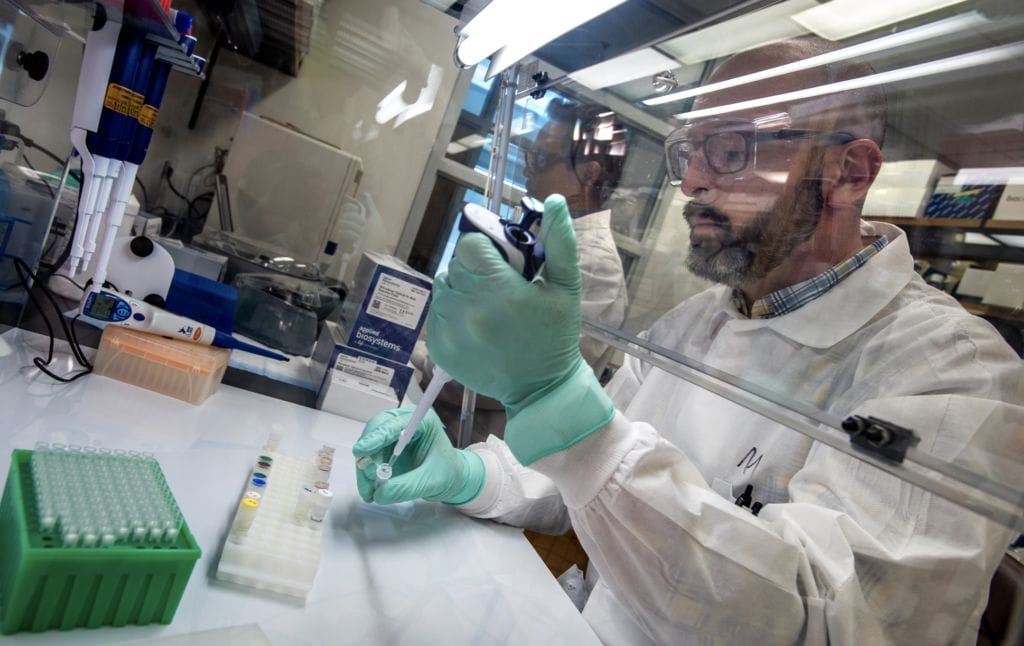New documentation shows that some of the the most secure and regulated high-containment biosafety laboratories in the US continue to have occurrences of mishaps, animal escapes, human errors, improper and defective personal protective equipment, facility equipment failures and containment failures.
That’s according to Judicial Watch’s recent acquisition of 25 pages of redacted records and communications from the Federal Select Agent Program (FSAP). They reveal safety lapses and violations at US biosafety laboratories that conduct research on dangerous agents and toxins.
The records were produced after a Judicial Watch January 25, 2022, Freedom of Information Act (FOIA) request to Federal Select Agent Program for: :Any and all records maintained by the U.S. Department of Agriculture including memoranda, draft memoranda, reports, email communications, email chains, investigative reports and other communications or data concerning accidents, investigations, incidents, spills, loss, theft, near miss hazardous events, and enforcement actions regarding any Select Agent or Toxin at Biosafety Level (BSL) 2, BSL 3 or BSL 4 laboratories.”
The Federal Select Agent Program “is jointly comprised of the Centers for Disease Control and Prevention/Division of Select Agents and Toxins and the Animal and Plant Health Inspection Service/Division of Agricultural Select Agents and Toxins. The Federal Select Agent Program oversees the possession, use and transfer of biological select agents and toxins, which have the potential to pose a severe threat to public, animal or plant health or to animal or plant products.”
Read Judicial Watch’s full account of what the records disclosed below:
On March 11, 2021, Federal Select Agent Program sends a letter to a recipient whose name is redacted titled, “Suspension of Registration.” The letter advises the entity that their certificate of registration “to possess, use, and transfer select agents and toxins is suspended” due to “failure to comply with the regulatory requirements.”
The letter further states: [T]he APHIS/CDC [Animal and Plant Health Inspection] … reports and notification of inventory discrepancies made in January 2019, October – November 2020, and most recently in January 2021, indicate systemic noncompliance with inventory record keeping and effective training requirements that would prevent these repeated occurrences.
Despite written assurances by the Responsible Official (RO) after each aforementioned incident that staff had been retrained on inventory practices and reminded of [the importance] of proper communication [redacted] continued to report inventory discrepancies.
Specifically, [redacted] systemic noncompliance with the ed by the following: The specifics of each of the incidents is redacted. The letter orders the entity to cease all activities with select agents and toxins except a “vial-by-vial inventory.”
Corrective actions were required to be completed by August 11, 2021, or the certificate of registration could be revoked, resulting in “all select agents and toxins a [redacted] will need to be transferred to a registered facility or destroyed.”
On March 11, 2020, the Agriculture Select Agent Services (AgSAS) sends a letter to a recipient whose name is redacted titled “Corrective Action Plan (CAP).” The letter indicates the “USDA-APHIS [Animal and Plant Health Inspection] Investigative Enforcement Services (IES)” sent a letter on February 27, 2020, “in which [redacted] agreed to meet with the CAP requirements outlined in [an] IES letter.
The March letter provides notice that failure to follow the plan of action could result in the “suspension or revocation of [redacted] certificate of registration for the possession, use and transfer of select agents and toxins….”
On February 19, 2021, Animal and Plant Health Inspection Services, sends a letter to a recipient whose name is redacted that includes the subject line “Suspension of Registration.” The letter advises the entity that their certificate of registration to possess, use, and transfer select agents and toxins is suspended due to failure to comply with regulatory requirements related to registration and restricted experiments; responsible official, and theft, loss or release; security; biosafety-general; incident response; training; and records keeping observed during a January 19-22, 2021, compliance inspection.
On July 19, 2019, then-CDC Director Dr. Robert R. Redfield sends a letter to then-Secretary of the U.S. Department of Health and Human Services (HHS) Alex M. Azar II titled: “Report to Congress on the Notifications of Theft, Loss, or Release of Select Agents and Toxins for Calendar Year 2018 – Decision:”
Between January 1, 2018 and December 31, 2018, the select agent regulatory programs at USDA and HHS received eight reports of BSAT [biological select agents and toxins] loss, 193 reports of BSAT release. and zero reports of a theft of a BSAT for calendar year (CY) 2018.
There were eight reports of a Joss (failure to account for BSAT), all from registered entities. [the Federal Select Agent Program] refers all reports of a BSAT loss to the Federal Bureau of Investigation (FBI). In CY 2018, the FBI determined that there was no criminal nexus for any of the eight reported losses.
None of the reported losses resulted in a risk to public or agricultural health; and there were 193 reports of a release (occupational exposure or release of BSJ\ T outside of the primary barriers of the biocontainment area).
Of these reports, 66 reports were submitted by registered entities and 127 reports were from non-registered entities. None of the reported releases resulted in illnesses, deaths, or transmissions among workers or outside of a laboratory into the surrounding environment or community.
A chart within the report reveals the release of biological select agents and toxins were attributed to: one bite or scratch from an infected animal; 138 manipulations of select agents or toxins outside a biological safety cabinet or other equipment designed to protect from exposure; nine equipment or mechanical failures; 22 failures of personal protective equipment; 10 needle sticks or other exposures; nine spills of select agents; and four escaped animals.
A report dated July 6, 2020, is titled “Report to Congress: Notifications of Theft, Loss, or Release of Select Agents and Toxins for Calendar Year 2019.” A summary of the report reads: During CY [calendar year 2019], [the Federal Select Agent Program] received 13 reports of losses , 219 reports of releases, and zero reports of thefts.
None of the releases resulted in illnesses, deaths, or transmissions to/or among workers. nor was there a BSAT [biological select agents and toxins] transmission to the outside of a laboratory into the surrounding environment or community. The FBI investigated all 13 report of losses and, in all cases, determined there was no criminal nexus.
A chart within the report indicates the releases of select agents or toxins were attributed to the following: four bites or scratches from an infected animal; 140 manipulations of select agents or toxins outside a biological safety cabinet or other equipment designed to protect from exposure; one decontamination failure; 10 instances of deviation from standard laboratory operating procedures, such as not wearing the appropriate personal protective equipment or other safety violation; 16 equipment or mechanical failures; 21 failures of personal protective equipment; two failures in performing inactivation methods or removal methods for select agents; 13 needle sticks or other exposures; 10 spills of select agent; and two escaped animals;.
A report from the USDA and HHS dated June 2021 is titled “Report to Congress: Notifications of Theft, Loss, or Release of Select Agents and Toxins for Calendar Year 2020.” A summary of the report indicates: During [calendar year 2020], [the Federal Select Agent Program] received 13 reports of losses, 158 reports of releases, and no reports of theft of [biological select agents and toxins].
None of the reported releases resulted in death or transmission among workers nor transmission to the outside of a laboratory into the surrounding environment or community.
FSAP [the Federal Select Agent Program] received one report from a non-registered entity of a release that resulted in an occupational illness in one worker that made a full recovery after receiving medical treatment. The FBI investigated all 13 reports of losses and, in all cases, determined there was no criminal nexus.
A chart within the report notes that the releases of select agent or toxin were attributed to the following: one bite or scratch from an infected animal; 92 manipulations of select agents or toxins outside a biological safety cabinet or other equipment designed to protect from exposure; one decontamination failure; five instances of deviation from standard laboratory operating procedures such, as not wearing the appropriate personal protective equipment or other safety violation; 19 equipment or mechanical failures; 13 failures of personal protective equipment; two failures in performing a validated inactivation or [biological select agents and toxins] removal method; 13 needle sticks or other exposures; 17 spills of select agent; and one escaped animal.
The report explains that one of the exposures resulted in an illness of one worker after exposure to Coxiella Burnetii.
“The source of the infection was attributed to contact with infected animals in the performance of the worker’s duties. The worker received medical treatment and fully recovered from the illness. The entity notified all workers potentially exposed to the infected worker and found no evidence of disease transmission to others.”
“These documents uncover a pattern of serious safety issues in biolabs here on U.S. soil,” stated Judicial Watch President Tom Fitton. “And, given these issues here at home, one can imagine the safety issues of labs the U.S. funds abroad.”
In June 2021, Judicial Watch, through a FOIA lawsuit, uncovered a January 19, 2018, State Department cable from the US Embassy in Beijing about the Wuhan Institute of Virology with the subject “China Opens First Bio Safety Level 4 Laboratory” that includes a section titled “Unclear Guidelines on Virus Access and a Lack of Trained Talent Impede Research,” which notes in its introduction that “its current productivity is limited by a shortage of highly trained technicians and investigators required to safely operate a BSL-4 laboratory and a lack of clarity in related Chinese government policies and guidelines.”

Visit the Lemonade Mermaid Store today
Original and Custom items for Land or Sea Mermaids




This sounds like a conglomeration of government bureaucracies that aren’t getting the job done. The level of ineptitude in our government continues to grow.
Just remember, Fauci funded gain-of-function research at Wuhan Lab and who knows where else and under what safety measures. Many believe the covid-19 virus “escaped” from the Wuhan Lab whose safety protocols were questionable. We now see many iterations of that virus over a short period of time. A clear sign it was engineered and not transmitted by wildlife to humans.
Hopefully, we remain diligent here in the US with our labs, but we must recognize that overseas labs are equally risky for all of us.
so now we know that NIH’s Peter Daszak’s lab in Wuhan was bad, but what about the (non-)safety at the dozens of US/NATO labs in Ukraine? it’s all very scary.
DIA: Intel suggests COVID virus was lab-engineered
By Bill Gertz – The Washington Times News & Analysis – Wednesday, May 11, 2022
https://www.washingtontimes.com/news/2022/may/11/dia-intel-suggests-covid-virus-was-lab-engineered/
Army Lt. Gen. Scott Berrier, director of the Defense Intelligence Agency, revealed in prepared Senate testimony this week that some U.S. intelligence agencies — not identified by name — believe the virus behind the COVID-19 pandemic may have been genetically modified in a laboratory and not transmitted naturally from an animal host in China, where it was first identified. Limited and fragmentary information on the virus origin led to multiple theories on the virus origin among the 17 agencies that make up the U.S. intelligence community, he said. Despite the uncertainty, all agencies claim the virus known as SARS-CoV-2 was not developed as a biological weapon. But Gen. Berrier added without elaborating that “most agree that it was not genetically engineered.” That suggests more than one intelligence agency has information pointing to the COVID virus still spreading worldwide as containing human-produced genetic modifications. It was the first time a government official disclosed on the record declassified intelligence indicating the coronavirus behind the pandemic could have been manipulated in a laboratory, a charge the Chinese government has fiercely denied…
A few years ago I learned of a lab where where someone from Fort Detrick sent a BSL3 strain by mistake. People were working this bug thinking it was harmless but getting no results, until they sequenced DNA and were like oh s#!+, that’s the pathogen! Fortunately nobody got sick, but seems that no action was taken by health and safety, at least like warning personnel, maybe they were not told.. Wonder how many incidents are not reported.